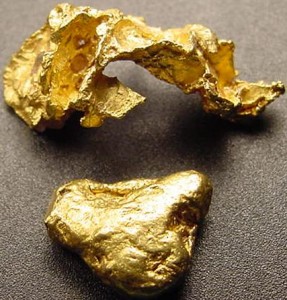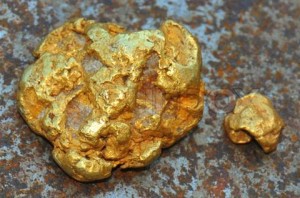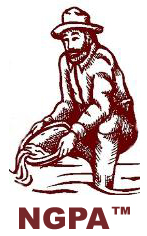Where to Find Gold Nuggets in the USA: Prospecting, Panning, Mining

 Believe it or not, one of the most common forms of collecting gold in the world today doesn’t include the finding of gold nuggets at all. Much of commercial gold mining involves harvesting gold that isn’t even visible to the naked eye. In many open-pit commercial mining operations, the gold is chemically leached out of large heaps of mined material by spraying it with a cyanide mixture. The cyanide chemically attracts the traces of gold in the dirt and rock, and the gold is separated from the cyanide after it flows in rivulets into special processing facilities.
Believe it or not, one of the most common forms of collecting gold in the world today doesn’t include the finding of gold nuggets at all. Much of commercial gold mining involves harvesting gold that isn’t even visible to the naked eye. In many open-pit commercial mining operations, the gold is chemically leached out of large heaps of mined material by spraying it with a cyanide mixture. The cyanide chemically attracts the traces of gold in the dirt and rock, and the gold is separated from the cyanide after it flows in rivulets into special processing facilities.
I grew up in a small town in rural Nevada that was there only because of the kind of open-pit, heap-leach gold mine described above. At the Round Mountain gold mine–one of the largest gold mines of its type in the country–you aren’t likely to ever find gold nuggets above or below the ground. Instead, rock and dirt are mined out of a massive pit on the facility, then trucked to heaps to be sprayed with the mixture of cyanide.
It is still possible, though, to find gold nuggets in the USA, although finding a valuable nugget sitting above the ground is a long shot. Most gold nuggets that are found by Americans today are discovered by amateur gold prospecting, gold panning and metal detecting. And while the average person might think of gold nuggets the size of rock candy like you’d see in the movies, the reality is that most gold flakes and nuggets you will pan out of a stream are of the much smaller variety.
Finding Gold Nuggets by Prospecting and Panning
For the average person in the USA who wants to find gold and who doesn’t have millions of dollars to start their own commercial mining operation, the most likely route is through amateur gold prospecting and panning. And contrary to popular belief, you can actually find gold in small amounts in almost every single state in the U.S. . . . not just western states like Nevada and California where old-time gold rush enthusiasts flocked to pluck nuggets out of streams more than a century ago.
It’s worth repeating to any treasure hunters out there who are dreaming about where to find gold nuggets in the US in places where they are sitting above the ground like shiny pebbles: it simply won’t happen. In order to find gold, you’re going to have to put some time an effort into identifying local streams where placer gold might exist, get the right equipment to harvest it, and learn how to properly prospect and pan it out of the sediment.
The good news is that amateur prospecting and panning for gold is easy to learn, very inexpensive to get started with, and can actually be a fun outdoor recreational activity even if you don’t end up striking it rich. You aren’t likely to find any big gold nuggets that will let you quit your job and buy a mansion, but you are likely to have fun and make a few extra bucks.
To start, do a little bit of searching to see if there are any streams or creeks within driving distance where people have panned gold successfully in the past (or used a metal detector to dig up). If someone has pulled gold out of a stream in the past, then there will definitely be more there for the taking. Make sure that it’s on land that you’re legally allowed to visit and pan on before going.
 Joining a local gold prospecting club can help you learn the hobby of recreational panning quickly and get more information about where the best creeks in your state are located. Even if you’re in a state where you think there isn’t much interest in finding gold, you might be surprised to discover that there is probably an amateur prospecting group or two that you can become a member of.
Joining a local gold prospecting club can help you learn the hobby of recreational panning quickly and get more information about where the best creeks in your state are located. Even if you’re in a state where you think there isn’t much interest in finding gold, you might be surprised to discover that there is probably an amateur prospecting group or two that you can become a member of.
After you’ve identified the best locations for finding gold in your state, you should invest around fifty bucks in a beginner’s gold prospecting starter kit. You can get a starter kit online fairly inexpensively, and it will include everything you need to start out right: a plastic gold pan, a how-to book, snuffer bottles, classifiers and tweezers.
As for the actual process of panning for gold nuggets, there are plenty of places online to get tutorials on the right methods, procedures and approaches (including right here on our website). You’ll get better as you pan for gold more often, and like any other hobby you might have to keep at it for quite some time before you finally find success. You can also use metal detectors to discover buried nuggets in gold-rich areas, but this is a skill that takes longer to learn.
So if you’re wondering where to find gold nuggets in the U.S., the good news is that it’s possible to do . . . sort of. You just have to keep your expectations realistic, get the right equipment, do the necessary research, and approach with the understanding that you might never make a lot of money in the process. You can definitely, though, teach yourself how to take part in a great outdoor recreational hobby that is fun to do and make you a little extra money in the process.

